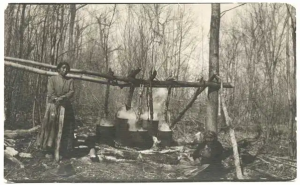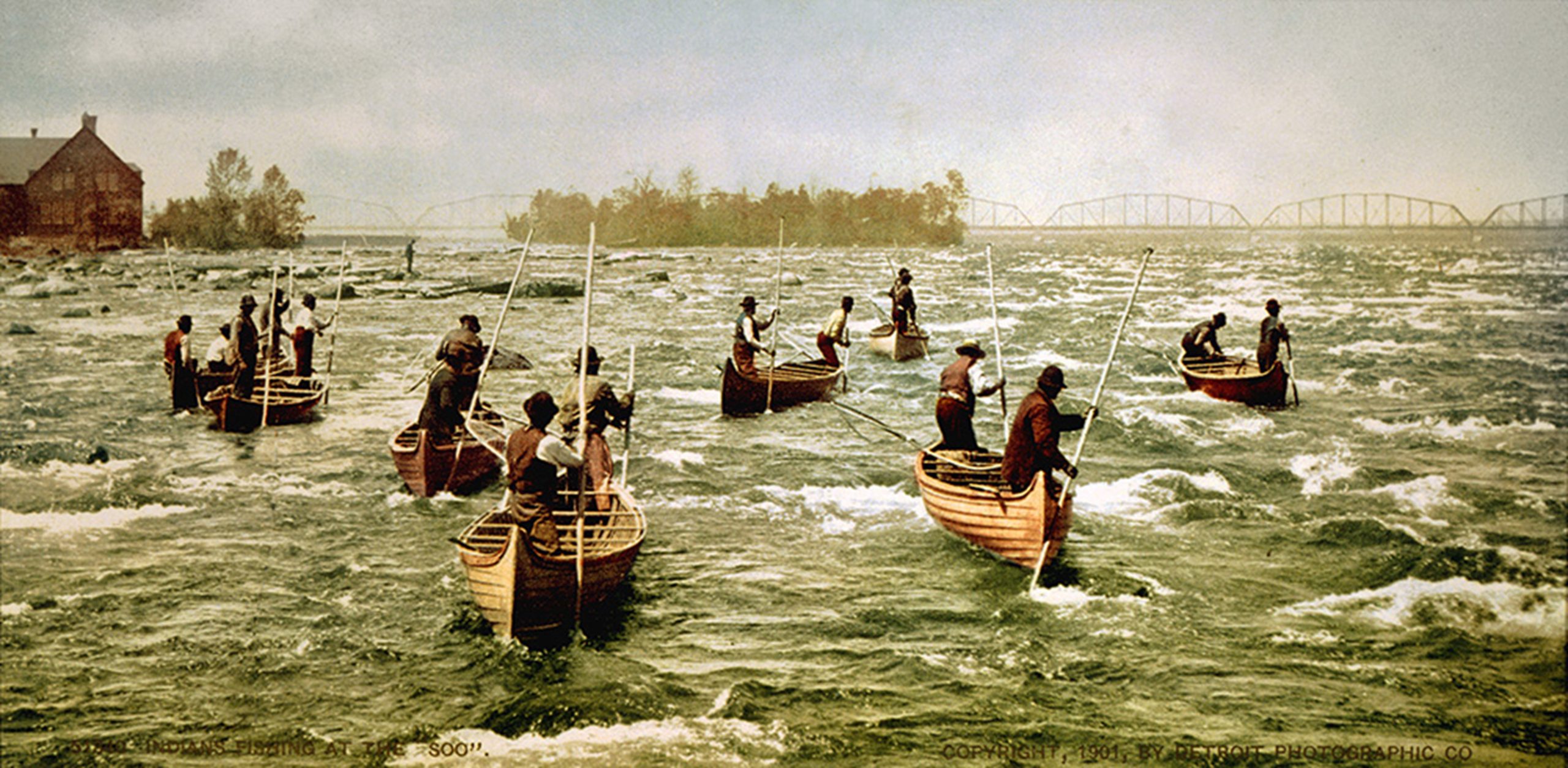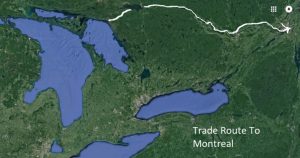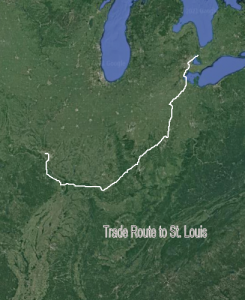Week 5: Lifestyles (Continued)
Seasonal Cycles Part 2
- Spring
- Sugar Camps

When the winter hunting season was over, the Ojibwe gathered in larger groups of six or more families at the sugar bushes. Sugar bushes were large stands of sugar maple trees. The camp consisted of a large fire pit where they boiled down the sap to make maple syrup. There was a main lodge where they packaged the sugar products in different containers for storage. The women and children tended the fires while the men tapped the trees and hauled the pails of sap to the camp using toboggans. Everyone helped with the running of the sugar camp.
Viewing Assignment 1
Maple Syrup plays an essential role in the stories of many different indigenous cultures in Canada. The Mi’kmaq people of New Brunswick share the story on their website, and an Anishinaabe historian, David Plain, tells the story in this video. https://www.youtube.com/watch?v=Oy7Jl7_v7Hs
Put aside the time to watch the entire 50-minute video. Take notes while you’re watching the video around some of the questions described below. Even better, watch the video with a few friends, either shared online or together watching the video.
There are a variety of teachings in the video, done in a variety of styles. When you think about the things you’ve learned, try to think about the concrete ones (2 ½ inches of depth into the tree) and how those kinds of learnings are different from other things available to you in the story.
Questions
- How would a ‘traditional’ educator look at this teaching? E.g. what are the learning objectives?
- What things do you feel relatively sure of that you have learned about this teaching? E.g. 2 ½ inches of depth for holes drilled in the tree)
- What things might you infer about maple syrup making from the video? E.g. the metal spigots are probably easier to use
- What other things might you learn from the teachings presented in the video Ziidbaatogeng (2020)? E.g. “Pauline taught me that trick (she says) “we used to do that at home.”
- How have you used interest in a certain kind of story to explain what belonging to a community of knowing means?
- What other teachings are there in the Gluskabe and Nanaboozhoo stories about the origin of the making of Maple Syrup?
- How did the cession treaties affect the indigenous people?
- How many times did the treaties affect the indigenous people in the story, “Stag Island was traded even up for a 400-acre sugarbush”?
Fishing Camps

The sugar-making season lasts only about three weeks. Then the family groups move to the fishing grounds to set up camps. Larger groups of families congregate at the best fishing spots, usually at the mouths of rivers or at or near rapids. The men would shoot the rapids standing in their canoes. The man at the stern would navigate, and the man in the bow, using a large dip net, would scoop up fish and, in one motion, throw them over his shoulder into the bottom of the canoe. Ojibwe canoeists were among the best in the world.
The women and children would have set up the fish processing camp at the foot of the rapids, where the men would stop to unload their catch. The fishermen would then return to the beginning of the rapids to shoot them once again.

Fishers also spearfished at night by torchlight. The light would attract fish to the surface, where a man in the bow would spear them. The Ojibwe practice spearfishing today even though it is frowned upon by the wider society.
Viewing Assignment 2
Spearfishing today in Wisconsin
They would also set up camps at a narrow place in the river, and the men would set up fish weirs in the water. The fish would swim into the weirs and not be able to escape. The photo below is remnants of traditional fish weirs at Mnjikaning or The Narrows between Lakes Couchaching and Simcoe in Southern Ontario.

Viewing Assignment 3
View the video https://www.tvo.org/video/documentaries/ep-1-the-fishing-chiefs for an understanding of the Ojibwe fishing industry in the late 19th century.
Summer
The people would move back to their main villages after the spring spawning runs were over. Summer was a time for rest from the work of producing their meat, sugar and fish products. They would spend days gathering berries and nuts as they ripened, tending their garden plots and going on trading trips. The community would gather around a large fire in the centre of the village on warm summer nights to listen to the traditional stories told by debadjahmaajig, the village storyteller. Each Ojibwe Band would set aside a few days for jiingtamog. Today these are called gatherings or powwows.
The British made contact with the Ojibwe after they lost the trading relationship with the Huron in 1650. The Ojibwe from the north shore of Georgian Bay were trading with the French at Montreal. They traded exclusively exchanging beaver pelts for European trade goods from the 1650s to 1701.

During the first decade of the 18th century, the Ojibwe moved into Southern Ontario. Then they added a trade route to Albany, New York, to trade with the British. They had exchanged a Dish-With-One-Spoon wampum belt with the Onandaga allowing them safe passage through Onandaga lands to get to the British trading post. Meanwhile, they kept trading with the French at Fort Ponchartrain, Detroit, playing one off against the other until the French lost the French and Indian War in 1760.

The Spanish had a trading post at St. Louis. They began making agreements with the First Nations in the Great Lakes basin, offering annual presents of trade goods for mercenary services in the 1770s. They were concerned about attacks by the Americans. The Ojibwe from the straits between Lakes Huron and Erie were among these First Nations.

Colonial Impact
As you understand how maple syrup production impacts the relationships between generations, are a site of cultural exchange and a food source, what are some of the colonial impacts on the Anishinaabe, consider the impact of the loss of land had on the peoples.
- How would you expect those losses to affect the Anishinaabe?
- Pass along what you’ve learned through one of your social activities. These activities could be anything from a dinner party to a Twitter account.
Reading Assignment 1
Read the following article: https://scholars.wlu.ca/cgi/viewcontent.cgi?article=1000&context=sjce_mrp
Read the following article from the Sarnia Journal. Look for the effects of colonialism on the Ojibwe’s sugarbush.

Viewing Assignment 4
https://pbswisconsin.org/watch/tribal-histories/wpt-documentaries-potawatomi-history/
Questions
After viewing assignment 4, see how many ways colonialism has affected the Potawatomi you can find. There are at least five.

